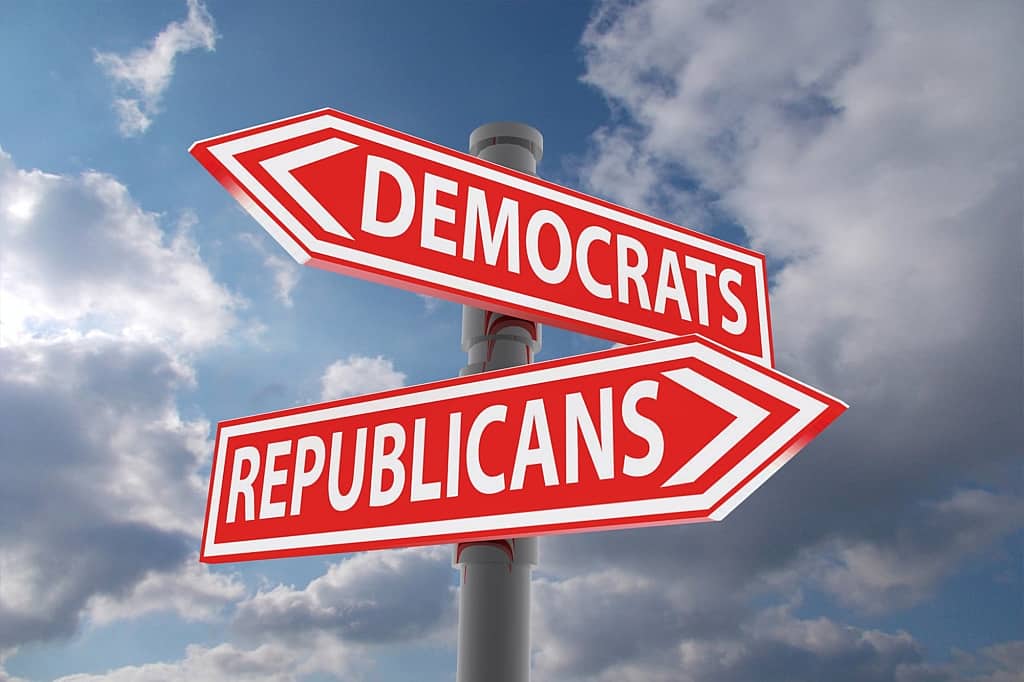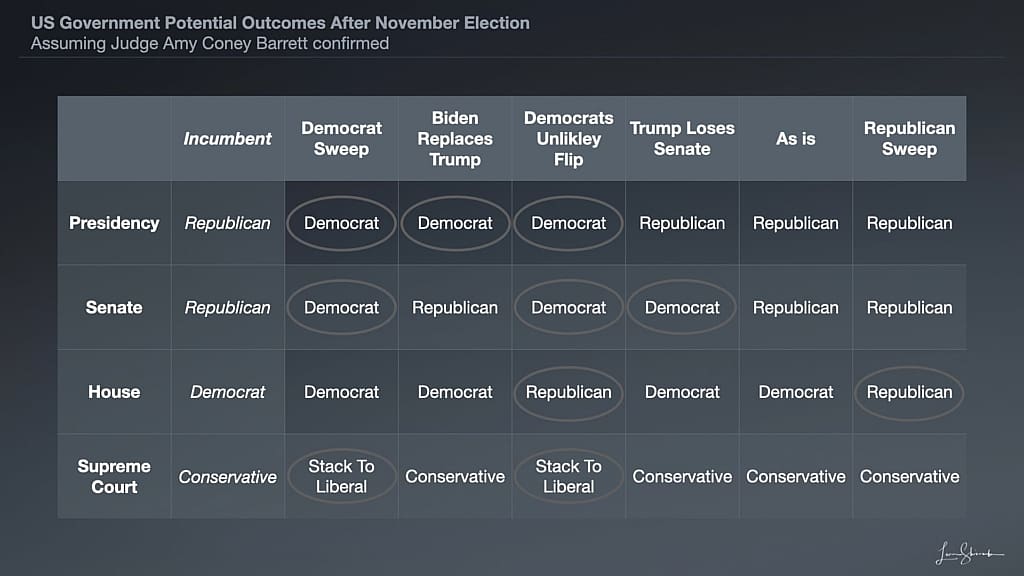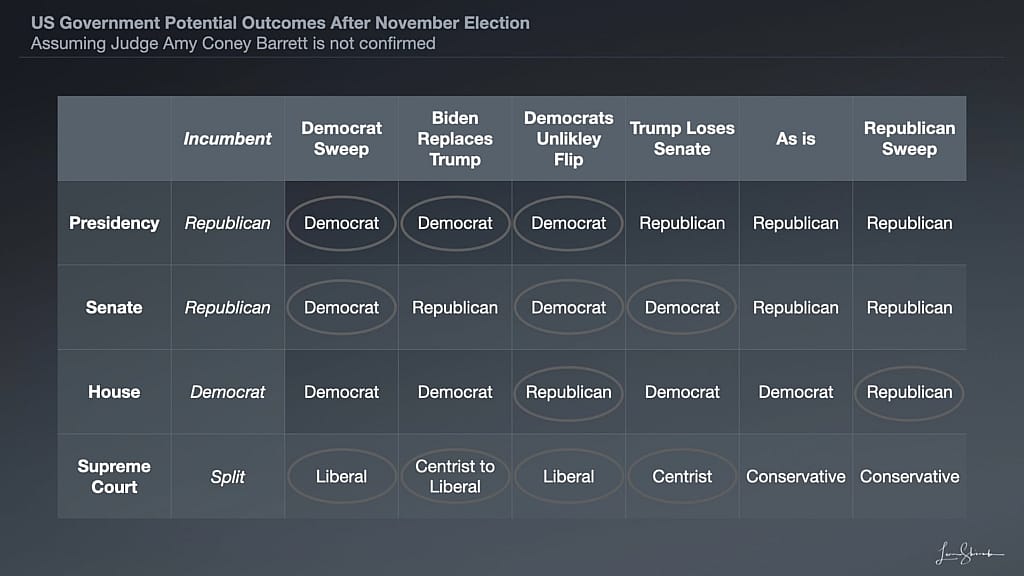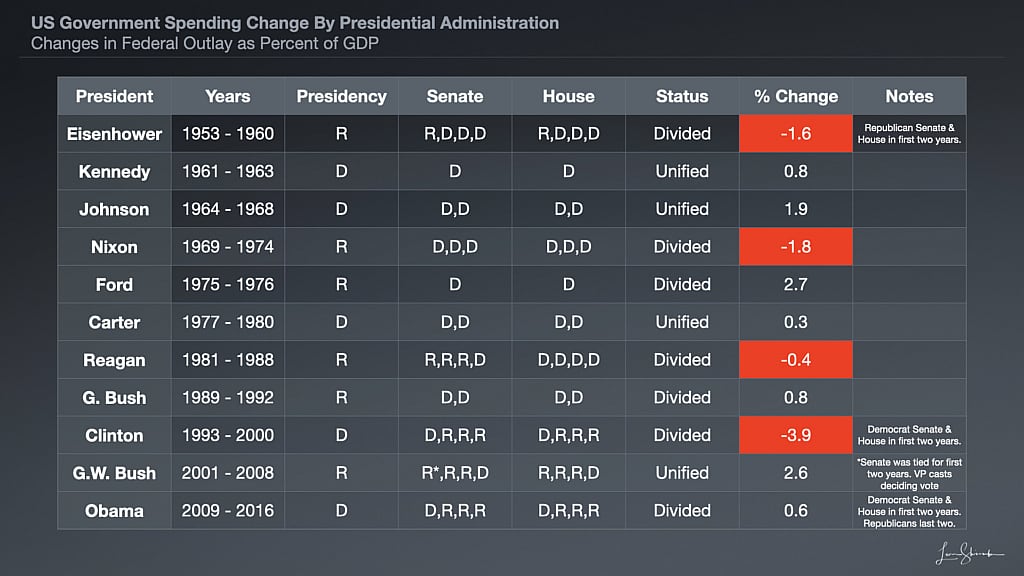Whenever the people are well-informed, they can be trusted with their own government.
Thomas Jefferson

Polarization and extreme politics have led to frustration with America’s divided government. Both parties are hoping for sweeps in the November election.
On October 2, 2020, the Gallup organization revealed their survey findings that 41%, a historic high percentage of Americans, now favor unified control of the federal government. Only 23% want divided control.
Historically, survey respondents have supported a unified government when their party is in power, and a divided government when they are not in power. That means Democrats typically prefer unified power when they control, while Republicans prefer divided. And Republicans prefer a unified government when they are in control, but Democrats prefer a divided government.
This year, respondents from both parties overwhelmingly support a unified government over a divided government for the first time.
But is that a good thing?
Is a unified federal government better for America, or a continued divided government?
Read on to find out more.
- The allure of a representative government
- Straying far from the electorate will have consequences.
- Coming to terms with the governance gap
- Designing a balanced representative government for the United States
- Where is our representative government headed?
- Which of the outcomes are more likely to occur?
- What are the weaknesses of a divided government?
- What are the benefits of a divided government?
- Hope for a divided government
The allure of a representative government
We are naturally attracted to the concept of a representative government.
Abraham Lincoln wrote that “Democracy is direct self-government, over all the people, by all the people, for all the people.”
The founders had a simple view of governments consisting of voluntary and amateur legislators who met to debate and responded to the people’s will.
As opposed to the traditional hierarchical monarchies or governance systems, our path envisioned the elected as serving the people, not ruling the people.
By and large, this system continues today in many small towns, villages, and school districts around the country.
But in large cities, and at the state and federal level, we now have a mutated abstraction of this principle that’s far from the original vision.
- Bureaucracies are far more significant and entrenched than those elected by the people.
- The elected are rarely an amateur volunteer. They are mostly professional politicians.
- Collectively, the elected and their bureaucracies are more interested in telling rather than listening. They seem more inclined to impose their own will (ruling) than represent their electorate (serving).
Straying far from the electorate will have consequences.
The dissonance caused by the gap between the people’s interests and entrenched bureaucrats has already created some interesting social shifts.
In 2016 Britons voted for Brexit, a separation from the European Union. Dissatisfied with the elites and the rules crafted by unelected bureaucrats with little connection to the average Briton’s reality, they chose a divorce.
Polling of voters showed that “Nearly half (49%) of leave voters said the biggest single reason for wanting to leave the Union was the principle that decisions about the the UK should be taken in the UK”.
For Brexiteers to succeed, they had to defeat the political elite in the UK. The leave voters rejected the two political powerhouses, the Conservatives and Labor parties, on their way to victory.
Similarly, in 2016, Donald Trump narrowly defeated the candidate favored to win the USA Presidency, Hilary Clinton.
Although running as the Republican nominee, Donald Trump had to overcome leaders in both political powerhouses, the Democrats and Republicans, on his way to victory.
Coming to terms with the governance gap
Now I know some of you are groaning and rolling your eyes at what you consider a gross simplification of the Brexit/Trump phenomena.
You will point out studies characterizing the Leavers and Trump supporters as the disgruntled left behind, the lesser-educated, those who are anti-immigrants, and several other unsavory descriptions.
That may be the case, but in doing so, you fall into the trap of ignoring the very essence of the idea of representative government.
The founding fathers envisioned a government for all the people, not all the people except for the lesser educated. Their premise of government was the opposite of elitism in which only the “smart people” decide.
Perhaps instead of disparaging the people who revolted against the ruler class as uneducated, the rulers should be more responsive to their electors’ needs.
Now we all know that the electorate is not always right. A representative government could lead to the tyranny of the oppressed and a crushing disregard for minority rights.
How then does one balance representation while avoiding minority oppression?
Designing a balanced representative government for the United States
Fortunately, the US federal government was structured to build many checks and balances to ensure representation and minority rights protection.
The separation of powers with executive, legislative, and judicial branches is a great example.
The Executive branch has many powers in running the government but is still held in check by the legislative branch and the judiciary.
With Congress, the legislative branch structure that balances a population-based house versus a state-based Senate is another brilliant design.
Term elections ensure a stable yet dynamic government. The Presidential term is four years, while members of the House of Representatives have two-year terms. Senators have six-year terms.
Finally, an electoral-college-based presidential election is simply genius.
The US Constitution grants certain powers to the federal government, and the Tenth Amendment reserves all other powers for the states and the people.
Indeed, the constitution requires that all states uphold a “republican form” of government. Although the three-branch structure is not required, all the state governments follow the federal government model and consist of three branches.
The design is such that while we have a representative government at the Federal and State level, we are likely to find parts of that government not reflective of the people’s will.
In Congress, each member of the House of Representatives is elected by and represents a district. And each district consists of roughly the same number of people as every other district. Each vote is equal and representative of an equivalent population.
On the other hand, there are two senators for every state, independent of their population. A Senator from California represents almost 20 million residents, while a Senator from Wyoming little less than 300 thousand. Their votes are equal, but not representative of similar populations. This twist of the representative government is a feature to protect minority rights. It is not a flaw in the design.
So naturally, at the federal and state levels of government, we are likely to see representative and fluid elements. In contrast, others are more stable and unrepresentative of the whims of the electorate.
The Supreme Court justice at the federal level receives a lifetime appointment. They are unlikely to be representative of the will of the people.
Senators may represent the people in their electorate, but because their populations are unequal, they are by design not intended to be fully representative.
The House and President, on the other hand, are elected by the populace generally and are generally more representative of the electorate.
Where is our representative government headed?
We discussed some examples of what happens when the gap grows so dramatically between those elected to represent and the electorate’s will.
Yes, meaningful changes occur!
Given how divided the populace and the seeming gap between the electorate and their government, we should expect consequential changes this November when the USA goes to the election.
The funny thing is that both sides believe the government does not represent their will.
What we will find out in November is the direction in which the gap is most significant.
What are the possible outcomes?
It is highly likely that the Senate confirms Judge Amy Coney Barret to the Supreme Court before the new administration. Let’s assume so for simplicity.
That means in January 2021, when the new administration begins, the outgoing or incumbent structure will be one where conservatives held majorities in the Presidency, Senate, and Supreme Court, while Liberals controlled the House.
With only three of the four branches up for grabs in the November election, we would expect six possible incoming government possibilities.
I have included the six possibilities assuming Judge Amy Coney Barrett is appointed.

Here are the possibilities if Amy Coney Barrett is not appointed before the new Administration is placed.

Which of the outcomes are more likely to occur?
The Supreme Court
In the Supreme Court, Judge Amy Coney Barrett seems likely to be nominated, creating a conservative majority.
If the Democrats sweep and win both the Presidency and the Senate, this conservative majority will likely be short-lived.
The Democrats have indicated their intent to remove the filibuster rule and likely use their control to push through new laws changing the court structure. The expectation is that they will end up stacking the court in a liberal direction.
The House of Representatives
The House currently has a Democrat majority, and it is unlikely that the Republicans will muster such a large scale revolt as to convert it into a Republican majority. In large part, that does depend on which direction the gap is most extensive, as discussed earlier.
The structure of the electorates and the House means that the larger populated states dominate the count. These heavily populated states have historically been Democrat strongholds. While some erosion is possible, it is highly unlikely to be that dramatic a shift.
The Senate
The Senate has a small Republican majority and could shift in either direction.
The Presidency
Democrats believe that their poll-leading candidate will win the Presidency. Republicans are counting on a repeat of the last election in which polls overlooked discontent of a significant segment of the population.
My crystal ball is not very good, so I am assuming the Presidency can shift in either direction.
Putting It All Together – Unlikely Outcomes
I don’t think the following possibilities are likely outcomes:
- The Unlikely Flip requires Democrats to win the Presidency and the Senate while losing the House. This outcome is improbable.
- The scenario in which Democrats win Congress, both the House and Senate, but Trump holds the White House is equally unlikely.
- A Republican Party sweep is possible but improbable given the steep hill to climb winning the House from the Democrats.
Likely Outcomes
Instead, I want to suggest that there are three equally likely conclusions of the November elections:
- The structure stays the same – Republicans control the Presidency, Senate, and Supreme Court, Democrats the House.
- There is a Democratic Party tilt where they win the Presidency and House, but the Republicans hold the Senate and the Supreme Court.
- The Democrats sweep.
In the first two outcomes, we have a divided government. With a Democrat sweep, we have a unified government structure, with single party control, as was in place for the first two years of the Obama administration.
Investors are generally assuming that we will continue to have a divided congress and government.
The stock market has not reacted poorly to the possibility of a Biden win, assuming that either Trump or Biden presiding over a split government is unlikely to unleash much legislative damage.
The market does not anticipate a democrat sweep, as that would likely result in dramatic departures on policy and legislative priorities, many of which will have unpredictable impacts on market participants.
What are the weaknesses of a divided government?
Many partisans don’t like a divided government because of the potential for gridlock and the likelihood of partisan bickering.
That may be so, but is that bad?
Despite being impeached by Republicans led by Newt Gingrich, Bill Clinton pushed his party to work with them. Together they introduced several major centrist legislation, including a reduction in government spending.
So too has Speaker Nancy Pelosi impeached Donald Trump. But she and the Democratic Party have agreed on very little with the Republican President and Senate.
Is gridlock to be feared when the alternative is the dominance of party politics and hyper-partisan legislation?
Shouldn’t we demand significant changes only occur when there is Bipartisan support?
What are the benefits of a divided government?
With a unified government, there is single party control and minimal incentive to involve the minority party out of power.
A divided government creates an incentive for both parties to work together.
Secondly, because in a divided government, both parties have to agree to pass any legislation, it creates an incentive for the legislation to be more centered. The result is an appeal to Independents and the middle ground rather than the extreme left of the democratic party or the Republican party’s extreme right.
The middle ground is typically better for more Americans than either extreme.
The reality is that significant reforms have a better chance of being sustained when enacted with bipartisan support.
Third, a divided government can lead to better oversight of the executive branch. With a unified government, we risk Congress acting like a lapdog to the White House rather than a watchdog. Oversight is an important check on executive power.
Fourth, government spending relative to the economy is most restrained under a divided government than unified governments, regardless of the party in control.
Since the 1950s, government spending cuts relative to the economy occurred under Presidents Eisenhower, Nixon, Reagan, and Clinton. Each occurred with a divided Congress. All others have increased government spending relative to the economy.

Finally, perhaps one of the most attractive benefits of a divided government has been the lower likelihood of entering a major war.
In the 20th century, all major wars were initiated by unified governments, where the same party held the Senate and Presidency.
The benefits of a divided government don’t just occur at the Federal level. They are evident at the state level also.
It is interesting that historically some states preferred a divided government over long periods. In New York, until recently, despite the party winning the governorship, New Yorkers voted a split state legislature with a Republican Senate and a Democratic Assembly.
States that have adopted unified governments have tended to have policies that are considered extreme to centrists.
Hope for a divided government
The two most dangerous possibilities for America are sweeps for Democrats or Republicans.
Regardless of how Americans feel about the liberal or conservative view, we have substantial portions of our population that belong to each.
A sweep in either direction leaves a substantially large group of Americans feeling unrepresented.
I know that some of you feel that your agenda is righteous.
But so does the other side.
We will not be better off by imposing the majority’s will over the minority in an autocratic way.
Sweeps lead to oppressive behavior.
When John McCain asked President Obama to consider Republican ideas in the formulation of the Affordable Care Act (Obamacare), he famously rebutted that his party had won. He was right, but that didn’t mean Democrats should ignore the other voices.
They did, and Democrats crafted Obamacare without Republican support.
I do not doubt that if the Republicans control all the government branches or if the Democrats once again regain control, we would repeat the insensitivity to the other voices.
For lasting meaningful legislation that is responsive to our populace, we need reasoned voices meeting in the middle.
Sweeps eliminate the middle, which is why they are so dangerous.
Democracy is direct self-government, over all the people, by all the people, for all the people.
Abraham Lincoln
If all the people are not in agreement, neither should their government.
I am hoping for a split decision this November. You should too.
What do you think?
I would love to hear your opinion.
Leon reading your blog reminds me of the my Political Ideology class in university. I do agree with your opinion of a split goverment which is the equivalent of a monitory goverment in Canada which forces bipartisan to get things done.
Each country’s political system has it pros and cons for the USA the separation of powers along with the check and balance makes a great model for democracy. However there are changes that will modernize the political system design by the founders.
1. Limit the number of times an elected official can run to 5 for the house of representations and 2 terms for the Senate. This ensures that the elected representatives will be more representative of the demographic by generation and migration to each state.
2: Reduce the age limit for Presidency to 3O as the minimum age requirement.
3. Review the electoral votes process to allow the presidential Candidates to win votes in state based upon the popular vote. Align the vote by county which means presidential candidates must appeal to the entire state to win all the electoral votes. I am sure this will not always happy but will it will be more representative of the state in terms of the support of the state.
4. All supreme court appointees within 6 month of an election should not be appointed until the new goverment in office. The decision will be more representative of the people verses trying to add more judges to balance the Supreme court. If an appointee is required within 6 months that will be a temporarily appointment which must be confirmed by the new majority of the senate.
The proposed changes will allow the current system to be more reflective of the people and also force bipartisan to get things done
Richard, I agree that many small improvements should be made.
I am a big fan of term limits.
Thinking back to when I was 30, I am not quite convinced that a 30-year-old has the necessary real-world experience to lead a nation. I am of the view that if they are 30, and capable, it’s only a five-year wait for them to show their skills.
The electoral voting system is quite elaborately designed to reflect the democratic republic design. There are lots of unintended consequences that could result from a change here, and I would be nervous about changes here.
On the Supreme Court, a lifetime appointment reduces bias, they don’t have to worry about employment after their career at the court. I have read a method of systematically rotating supreme courts that sounds interesting, but would need to really play out the consequences to be able to seriously judge those suggestions.
The trick is to make improvements that do not undermine the principles of the genius design envisioned by the founding fathers. That will take serious politicians interested in what’s best for the country, not what’s best for their party.